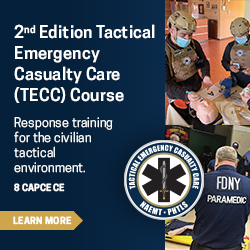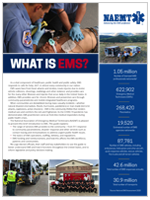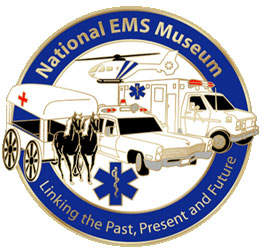Frequently Asked Questions About EMS
-
EMS stands for emergency medical services. EMS practitioners provide prehospital emergency medical care. People call EMS when they have had an accident or are experiencing a medical emergency, including heart attack, difficulty breathing, a fall or accident, drowning, cardiac arrest, stroke, drug overdose or acute illness. EMS may provide both basic and advanced medical care at the scene of an emergency and en route to a hospital.
-
EMS is more than an ambulance service. It includes the call center that receives the call for and dispatches help, those who respond first (such as police officers and firefighters), an ambulance transportation team of EMTs and/or paramedics, physicians and nurses who provide advice via radio or phone, air medical services (helicopters and small airplanes), hospital receiving facilities, and governmental and medical oversight.
-
When a person becomes ill or injured and dials 911, the call is answered by an EMS dispatcher, who is trained to obtain key information from the caller about the location and type of emergency. The dispatcher also may give the caller patient care instructions while sending emergency responders to the scene of the emergency.
These responders include:
- Emergency Medical Responders
- Emergency Medical Technicians (EMTs)
- Advanced Emergency Medical Technicians
- Paramedics
The training level needed for EMS practitioners is a state decision. Each level of EMS practitioner is trained to perform different skills to assist patients.
EMS practitioners work under protocols approved by a physician medical director, who oversees the care of patients in the EMS system and is knowledgeable about patient care interventions and how EMS systems deliver care. Typically, EMS medical directors work in conjunction with local EMS leaders to assure quality patient care. Many of these medical directors are members of the National Association of EMS Physicians. The medical director oversees the care of patients in the EMS system, and he or she is knowledgeable about patient care interventions and how EMS systems deliver care.
EMS care may be provided by private ambulance companies, fire or police departments, a public EMS agency, a hospital or by a combination of these. EMS practitioners may be paid workers or community volunteers.
-
Often EMS systems are “tiered.” This means that different levels of EMS practitioners may respond to a scene. In many EMS systems, it is common to have basic level EMS professionals (emergency medical responders and EMTs) respond to a scene first. They are then followed by paramedics trained in advanced life support. The structure of EMS response varies greatly around the United States based on location, resources, local leadership and history.
-
In most locations in the United States, the first step you must take to work in EMS is to take courses to become an emergency medical technician. This is the minimum level of education that most EMS professionals have before entering the workforce. Individuals who work as firefighters or police officers may perform some emergency medical work when trained as emergency medical responders. Some paramedic programs provide an all-inclusive program that includes both EMT and paramedic training in one program. All levels of EMS training are set by the federal government through the National Highway Traffic Safety Administration.
-
Where can I obtain training in EMS?
Training is offered at many community colleges, technical schools, hospitals, universities and EMS, fire and police academies. If you are interested in EMS training, you may contact your state EMS office or the Committee on Accreditation of EMS Professionals (CoAEMSP). Both of these agencies will help you find local training in your area.
-
Training to be an EMT or paramedic varies from depending on the training site and hours of class scheduled per week. Some training programs have class every day for a couple of months for those interested in quickly completing the program, while other, longer programs accommodate those students who have family, a full-time job or other responsibilities that limit their time available for education.
-
An EMT must be proficient in CPR, and training is centered on recognizing and treating life-threatening emergencies outside the hospital environment. An EMT learns the basics in how to handle cardiac and respiratory arrest, heart attacks, seizures, diabetic emergencies, respiratory problems and other medical emergencies. He or she also learns how to manage traumatic injuries such as falls, fractures, lacerations and burns. An EMT is also introduced in patient assessment, history taking and vital signs.
-
What skills does an EMT perform?
EMTs can perform CPR, artificial ventilations, oxygen administration, basic airway management, defibrillation using an AED, spinal immobilization, monitoring of vital signs and bandaging/splinting. They also may administer nitroglycerin, glucose, epinephrine and albuterol in special circumstances.
-
What skills does a paramedic perform?
A paramedic has extensive training in patient assessment and participates in a variety of clinical experiences during training. He or she can perform all of the skills performed by an EMT, plus advanced airway management such as endotracheal intubation, electrocardiographs (ECGs), insertion of intravenous lines, administration of numerous emergency medications, and assessment of ECG tracings and defibrillation.
-
Do EMTs and paramedics need a license?
Every state in the United States has a lead EMS agency or state office of EMS that determines requirements of EMS professionals in their state. Some state EMS offices issue licenses to EMS practitioners; others do not. All EMS practitioners are required to complete continuing education classes so they can stay current in medical treatment standards and protocols.
-
How much do EMTs and paramedics earn?
According to the U.S. Department of Labor Bureau of Labor Statistics, the earnings of EMTs and paramedics depend on their employment setting, geographic location, and training and experience. View median pay. Volunteers in general are not paid but some receive nominal monies for their services and some are able to earn pensions.




 ترجمة
ترجمة





